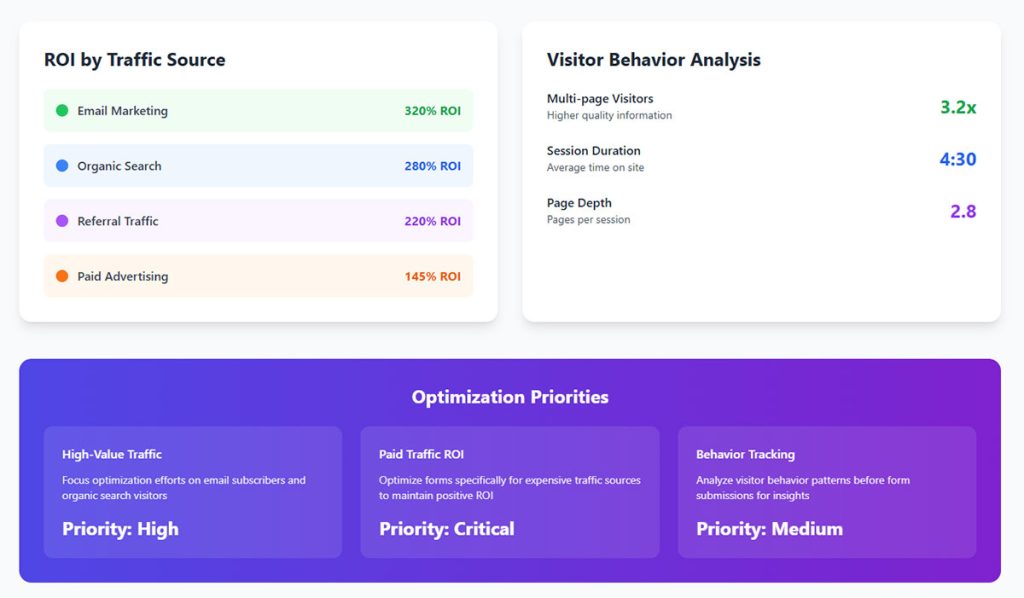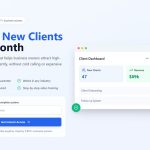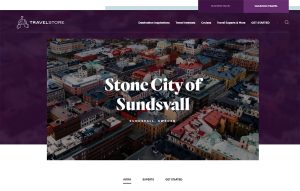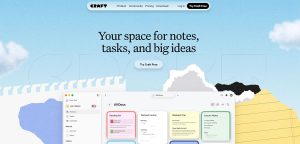Your website gets traffic, but your calendar stays empty. Lead generation for travel companies isn’t about attracting more visitors. It’s about converting browsers into bookers. Most travel businesses waste money…
Table of Contents
Website visitors scroll past your content every day without leaving contact information. Each missed conversion represents lost revenue and growth opportunities that competitors might capture instead.
Learning how to use website forms for lead generation transforms anonymous traffic into qualified prospects. Strategic form placement, compelling lead magnets, and optimized user experience create consistent lead flow that fuels business growth.
Effective lead capture requires more than basic contact forms. Modern prospects expect value exchanges that justify sharing personal information. Email marketing success depends on building subscriber lists through targeted conversion strategies.
This guide covers proven techniques for maximizing form conversions. You’ll discover optimal placement strategies, compelling incentive creation, technical implementation best practices, and performance optimization methods.
Master these lead generation fundamentals to build sustainable customer acquisition systems that generate consistent sales pipeline growth.
Planning Your Lead Generation Form Strategy
Identifying Your Target Audience and Their Needs
Creating buyer personas drives form success. Understanding who fills out your forms shapes every design decision. Demographics matter, but behavioral data reveals more about conversion patterns.
Study your visitors’ pain points. Research what problems they’re trying to solve when they land on your pages. Survey existing customers about their decision-making process. This insight guides which information to request and what value to offer.
Understanding Visitor Intent at Different Pages
Blog readers have different needs than product page visitors. Someone downloading a guide wants education. A pricing page visitor might be ready for a sales conversation.
Map visitor intent to contact form complexity. Educational content works with simple email capture. Product demos require more qualifying questions.
Track behavior patterns across your site. Heat mapping reveals where users focus attention. Analytics show which pages generate the most engaged visitors.
Matching Form Complexity to Audience Familiarity
New visitors need simple opt-ins. Returning visitors will complete longer forms for valuable resources.
Cold traffic converts better with minimal friction. Research shows that reducing form fields from four to three can increase conversion rates by nearly 50%. Warm prospects from email campaigns accept multi-step processes for exclusive content.
Progressive profiling builds relationships gradually. Start with basic contact information. Add qualifying questions in follow-up interactions. Companies using this approach have seen lead generation improvements of up to 276% compared to traditional single-form strategies.
Setting Clear Goals for Each Form
Every form needs a specific purpose. Generic “contact us” forms underperform targeted lead capture tools. Industry data shows that landing pages average conversion rates between 2-5%, but targeted forms can achieve much higher results.
Defining What Makes a Qualified Lead
Sales teams need qualified prospects, not just email addresses. Define lead scoring criteria before building forms.
Consider company size, budget range, timeline, and decision-making authority. Include qualifying questions that filter prospects naturally.
Quality beats quantity in lead generation. Ten qualified leads outperform a hundred unqualified contacts. In fact, 70% of B2B marketers now prioritize lead quality over volume, as only about 20% of leads typically result in sales.
Choosing the Right Conversion Goals
Match goals to page context and visitor stage. Newsletter signups work for awareness content. Demo requests fit solution-focused pages.
Consider these common conversion objectives:
- Email list growth for nurture campaigns
- Sales qualified leads for immediate follow-up
- Content downloads for education-based marketing
- Event registrations for community building
- Assessment requests for personalized solutions
Aligning Forms with Business Objectives
Connect form strategy to revenue goals. Calculate how many leads each salesperson can handle effectively.
Track conversion rates from lead to customer by traffic source. This data informs where to place your highest-converting lead generation form designs.
ROI tracking validates form performance. Measure cost per lead against customer lifetime value. Companies that excel at lead nurturing generate 50% more sales-ready leads at 33% lower cost, making this measurement crucial for sustainable growth.
Mapping Forms to Customer Journey Stages
Awareness Stage Form Requirements
Early-stage visitors need educational value. Offer industry reports, trend analyses, or problem-solving guides.
Keep forms short. Email address plus company name provides enough segmentation data.
Use subscription forms for ongoing content delivery. Position these in blog sidebars and content upgrades.
Consideration Stage Information Gathering
Mid-funnel prospects compare solutions. They’ll provide more information for comparative resources.
Request job title, company size, and current challenges. This data enables personalized follow-up sequences.
Gated comparison guides perform well here. Buyers actively research options and appreciate comprehensive analysis.
Decision Stage Conversion Forms
Bottom-funnel forms focus on sales qualification. Demo requests and consultation bookings need detailed prospect information.
Include budget ranges, implementation timelines, and decision-maker status. Sales teams need this context for effective conversations.
Use conditional logic to show relevant questions based on company type or use case.
Designing High-Converting Lead Forms
Key Elements of Effective Form Design
Visual hierarchy guides user attention. Clean layouts with plenty of white space reduce cognitive load. Research shows that CTA buttons surrounded by white space can increase conversion rates by over 200%. Cluttered forms overwhelm visitors and increase abandonment rates.
Professional appearance builds trust. Consistent branding and polished design elements signal credibility to potential leads.
Clear Headlines That Explain Value
Headlines communicate what visitors receive in exchange for their information. “Get our newsletter” underperforms “Get weekly marketing tips that increase revenue.”
Benefit-focused headlines convert better than feature descriptions. Focus on outcomes rather than deliverables.
Test emotional triggers in headlines. Fear of missing out, exclusive access, and time-sensitive offers increase urgency.
Strategic Use of White Space
Crowded forms feel overwhelming. Strategic spacing between elements improves readability and completion rates.
Group related fields together. Use visual separation to break complex forms into digestible sections.
Consider multi-step forms for lengthy information requests. Progress indicators reduce abandonment by showing completion status.
Mobile-Friendly Responsive Design
Mobile traffic dominates most websites. With over 62% of global web traffic now coming from mobile devices, forms must function perfectly on small screens or lose significant conversions.
Large touch targets prevent input errors. Adequate spacing between buttons reduces accidental clicks.
Mobile forms need simplified layouts. Stack fields vertically and minimize horizontal scrolling. However, 84% of people still prefer filling out forms on desktop computers when possible.
Writing Compelling Form Copy
Creating Headlines That Grab Attention

Specific benefits outperform generic promises. “Download our guide” becomes “Get the 47-point SEO checklist that doubled our traffic.”
Numbers add credibility. Statistics, timeframes, and specific results make offers more compelling.
Question-based headlines work well. “Ready to double your conversion rate?” engages visitors better than statements.
Writing Descriptions That Show Benefits
Explain what visitors gain from completing the form. List specific outcomes they can expect.
Address common objections in form copy. “No spam, unsubscribe anytime” reduces email capture resistance.
Use social proof when possible. “Join 15,000+ marketers who get our weekly tips” leverages community appeal.
Using Action-Oriented Button Text
“Submit” buttons underperform descriptive alternatives. “Get my free guide” or “Start my trial” clearly communicate the next step.
Studies show that changing button text from second person to first person (“Get my free template” instead of “Get your free template”) can result in a 90% increase in clicks.
Match button text to the promised outcome. Consistency between offer and action reduces confusion.
Test button colors against your site’s color scheme. Contrasting colors draw attention without clashing with overall design.
Adding Trust Signals and Social Proof
Customer testimonials near forms increase conversion rates. Include company logos, review scores, or user counts when relevant.
Privacy statements address data concerns. Link to your privacy policy and explain how you protect subscriber information. Security concerns cause 29% of form abandonment.
Security badges build confidence for sensitive information requests. Studies show that forms with trust badges can lead to a 42% increase in conversions. SSL certificates and compliance certifications reduce form abandonment.
Choosing the Right Form Fields

Balancing Information Needs with User Experience
Every additional field reduces conversion rates. Request only information you’ll actually use for follow-up or segmentation.
Required fields should provide essential value. Optional fields can gather nice-to-have data without blocking conversions.
Consider the perceived value exchange. High-value offers justify more information requests than basic content downloads.
Required Versus Optional Field Strategies
Mark required fields clearly. Asterisks or colored labels help users understand which information is necessary.
Use smart defaults when possible. Pre-fill location data or company information based on IP address or previous visits.
Optional fields provide qualification data. Include budget ranges, timeline questions, or interest categories as non-required options.
Smart Field Ordering and Grouping
Start with easy questions. Name and email feel less intrusive than budget or company size inquiries.
Group related information together. Contact details, company information, and project requirements should appear in logical sections.
Save sensitive questions for last. Once users invest time in completion, they’re more likely to finish despite personal information requests.
Using Progressive Profiling Techniques
Collect additional data over time rather than requesting everything upfront. Email marketing platforms can track known information and skip completed fields.
Progressive profiling reduces form abandonment. New visitors see minimal fields while returning prospects complete more detailed information. Since 81% of people abandon forms after beginning to fill them out, this approach significantly improves completion rates.
Track engagement levels to determine optimal profiling timing. Highly engaged subscribers accept more detailed questioning than casual visitors.
Consider lead capture forms that adapt based on visitor behavior. Show different fields to organic traffic versus paid campaign visitors.
Form validation ensures data quality while progressive profiling builds comprehensive prospect profiles gradually.
Form Placement and Timing Strategies
Strategic Placement on Your Website

Location determines conversion rates. High-traffic areas generate more leads, but context matters more than visibility.
Above-the-Fold Positioning for Key Pages
Place primary conversion forms where visitors see them immediately. Landing pages benefit from prominent form placement above the fold, as research shows that above-the-fold content captures 57% of users’ viewing time.
Homepage forms capture general interest. Product pages need specific lead magnets that match visitor intent.
Test different positions on high-traffic pages. Sometimes moving a form 200 pixels down increases conversions significantly. In fact, studies have shown that below-the-fold placement can sometimes deliver up to 220% higher conversion rates than above-the-fold positioning.
Sidebar Forms for Ongoing Visibility
Blog sidebars maintain constant lead capture opportunities. Newsletter signups perform well in consistent sidebar placement.
Sticky sidebars follow users as they scroll. This persistent visibility increases form completion rates for engaged readers.
Match sidebar offers to content topics. A social media guide works better on social marketing posts than generic “subscribe” requests.
Footer Forms for Non-Intrusive Capture
Contact us page footers provide backup conversion opportunities. Visitors who read entire pages show high engagement levels.
Footer forms work well for newsletter subscriptions and general inquiries. Keep these simple with minimal required fields.
Non-intrusive placement builds trust. Users appreciate forms that don’t interrupt their browsing experience.
In-Content Forms Within Blog Posts
Embed relevant forms within blog content. Readers engaged with specific topics convert better on related offers.
Place forms after valuable sections. Once readers gain insights, they’re more likely to exchange contact information for additional resources.
Use contextual lead magnets. A conversion optimization article should offer conversion-related resources, not generic marketing guides.
Pop-up and Overlay Form Tactics
Exit-Intent Pop-ups to Capture Leaving Visitors
Exit intent popup technology detects when users are about to leave. This timing captures visitors who might otherwise disappear forever.
Exit-intent popups have proven highly effective, with average conversion rates of 11% and the ability to convert an additional 2-4% of website visitors who would otherwise leave.
Offer valuable resources at exit. Visitors already demonstrated interest in your content, so targeted offers perform well.
Exit-intent forms recover abandoning traffic. Even low conversion rates add qualified leads from visitors who would otherwise leave.
Timed Pop-ups Based on Engagement
Display forms after visitors spend specific time periods on pages. Engaged readers are more likely to complete lead capture forms.
Test different timing intervals. Some audiences respond to 30-second delays while others need longer engagement periods.
Combine time-based triggers with scroll depth. Visitors who read 50% of an article show genuine interest in your content.
Scroll-Based Triggers for Content Consumption
Trigger popup forms when visitors scroll specific percentages down pages. This indicates genuine engagement with your content.
Research shows that a scroll depth of 75% is a good indicator of user engagement with long-form content, making this an ideal trigger point for forms.
Bottom-of-page triggers work well for comprehensive articles. Readers who finish content are prime candidates for related resources.
Scroll triggers feel less intrusive. Users control when they see forms based on their reading behavior.
Balancing Effectiveness with User Experience
Limit popup frequency to avoid annoying visitors. Once per session or once per day prevents form fatigue.
Provide easy dismissal options. Clear close buttons and escape key functionality respect user preferences.
A/B testing reveals optimal popup timing and frequency for your specific audience. Monitor bounce rates to ensure forms don’t drive visitors away.
Landing Page Form Optimization
Dedicated Landing Pages for Specific Campaigns
Campaign-specific landing page forms match visitor expectations. Paid traffic converts better when messaging aligns perfectly.
Remove navigation distractions from conversion-focused pages. Every additional link provides an escape route from your conversion goal.
Single-purpose pages outperform multi-objective designs. Focus landing pages on one specific conversion action. The average landing page conversion rate is 6.6% across all industries, but focused pages perform significantly better.
Removing Navigation Distractions
Hide main site navigation on dedicated landing pages. Visitors should complete forms or leave, not browse other sections.
Minimize external links in landing page content. Each outbound link reduces conversion rates by providing alternative actions.
Use breadcrumbs sparingly. Only include navigation when visitors need context about their location within your site.
Matching Form Content to Traffic Source
Customize form offers based on traffic sources. Social media visitors have different needs than search engine users.
Email campaign landing pages should reference the specific offer mentioned in emails. Consistency between message and landing page increases conversions.
Personalization improves conversion rates. Dynamic content that matches visitor behavior performs better than generic forms. Personalized CTAs can improve performance by up to 202% compared to generic alternatives.
A/B Testing Different Page Layouts
Test form placement against content positioning. Sometimes moving testimonials above forms increases trust and conversions.
Research shows that 70% of brands increase revenue from landing pages using A/B testing, and websites with 10-15 landing pages generate 55% more leads than those with fewer pages.
Experiment with single-column versus multi-column layouts. Mobile-first design often favors simplified, vertical arrangements.
Try different headline and subheadline combinations. Small copy changes can significantly impact form completion rates.
Creating Valuable Lead Magnets and Incentives
Content-Based Lead Magnets

Ebooks and Comprehensive Guides
Detailed guides establish expertise while capturing qualified leads. Visitors who download comprehensive resources demonstrate serious interest in your solutions.
Focus on actionable content that provides immediate value. Generic information fails to justify contact information exchange.
Industry-specific guides perform better than broad topics. A “SaaS Marketing Guide” converts better than “Digital Marketing Basics” for software companies.
Templates and Checklists
Practical tools save visitors time and effort. Registration form templates and workflow checklists provide immediate utility.
Templates work especially well for business audiences. Professionals appreciate resources that streamline their daily tasks.
Actionable formats generate higher-quality leads. People who use your tools are more likely to consider your services.
Industry Reports and Research
Original research positions your company as a thought leader. Survey data and trend analysis attract industry professionals.
Partner with research firms or conduct customer surveys to gather unique insights. Exclusive data commands premium lead capture value.
Include specific statistics and actionable insights. Prospects need concrete information they can apply immediately.
Video Tutorials and Courses
Educational video content appeals to visual learners. Step-by-step tutorials provide significant value for contact information.
Mini-courses delivered via email create ongoing engagement opportunities. Multi-part content extends the relationship beyond initial capture.
Video content often generates higher engagement. Visual demonstrations feel more valuable than text-based resources.
Service-Based Incentives
Free Consultations and Assessments
Personal consultations provide high-value exchanges for detailed contact information. Prospects appreciate customized advice for their specific situations.
Registration forms for consultations should include qualifying questions. This preparation makes calls more valuable for both parties.
Limit consultation availability to create urgency. “5 spots remaining this month” encourages immediate action.
Product Demos and Trials
Software companies benefit from hands-on product experiences. Interactive demos showcase capabilities better than static descriptions.
Free trials require more commitment from prospects. Users who install software show higher purchase intent than content downloaders.
Trial users provide detailed behavioral data. Track feature usage to identify the most engaged prospects for sales follow-up.
Exclusive Webinars and Events
Live events create community and demonstrate expertise. Webinar attendees often become highly qualified sales prospects.
Exclusive access appeals to professional audiences. “Members-only” positioning increases perceived value of registration.
Record events for post-registration access. This extends the value and accommodates different time zones and schedules.
Personalized Recommendations
Customized advice based on prospect information provides significant value. Assessment tools that generate personalized reports work well for complex services.
Use survey form data to create tailored recommendations. This personalization justifies more detailed information requests.
Personalization increases conversion rates. Custom recommendations feel more valuable than generic content offers.
Matching Incentives to Your Audience
Understanding What Your Prospects Value Most
Research your target audience’s biggest challenges. Customer interviews reveal which problems prospects prioritize most urgently.
Different industries value different incentive types. Technology companies might prefer data and case studies while creative agencies appreciate design resources.
Monitor which lead magnets generate the highest-quality prospects. Conversion to customer rates reveal true value of different offers.
Creating Urgency Without Being Pushy
Limited-time offers create natural urgency. “Available this week only” encourages immediate action without aggressive pressure.
Quantity limitations work well for consultations and personal services. “10 spots remaining” provides scarcity without artificial deadlines.
Authentic urgency performs better than manufactured scarcity. Real limitations feel more trustworthy than arbitrary countdowns.
Refreshing Offers to Maintain Effectiveness
Rotate lead magnets regularly to prevent audience fatigue. The same offers lose effectiveness over time with repeat visitors.
Test seasonal relevance for different offers. Tax preparation tools work better in early spring while holiday marketing guides peak in fall.
Track performance metrics over time. Declining conversion rates often indicate the need for fresh incentive options.
Technical Implementation and Best Practices
Form Functionality and User Experience
Page speed impacts conversion rates directly. Forms that load slowly lose prospects before they even see your offer.
Optimize image sizes and minimize HTTP requests. Compress assets and use content delivery networks for faster loading times across all geographic locations.
Fast Loading Times and Smooth Operation
Test form performance on various devices and connection speeds. Mobile users on slower networks abandon forms that take more than 3 seconds to load.
Cache form assets when possible. Static elements like CSS and JavaScript files should load from browser cache on repeat visits.
Eliminate unnecessary form elements. Every additional script or plugin increases loading time and potential failure points.
Clear Error Messages and Validation
Form validation should occur in real-time as users complete fields. Immediate feedback prevents submission errors and frustration.
Write helpful form error message text that explains exactly what needs correction. “Invalid email” becomes “Please enter a valid email address like [email protected].”
Highlight problematic fields with color and clear indicators. Users should immediately understand which information needs adjustment.
Confirmation Messages and Next Steps
Form submission confirmation message options include redirects to thank-you pages or inline notifications. Both approaches work when implemented properly.
Explain what happens next in confirmation messaging. “Check your email in 5 minutes for your download link” sets clear expectations.
Provide backup contact options. Include phone numbers or support emails in case automated delivery fails.
Auto-Fill Capabilities for Return Visitors
Browser auto-fill functionality speeds form completion for returning visitors. Structure field names and types to trigger auto-fill suggestions.
Web forms with consistent naming conventions work better with auto-fill. Use standard field names like “email,” “phone,” and “company” for optimal compatibility.
Progressive profiling systems remember visitor information across sessions. Known prospects see pre-filled forms with only new questions displayed.
Security and Privacy Considerations
GDPR and Privacy Law Compliance
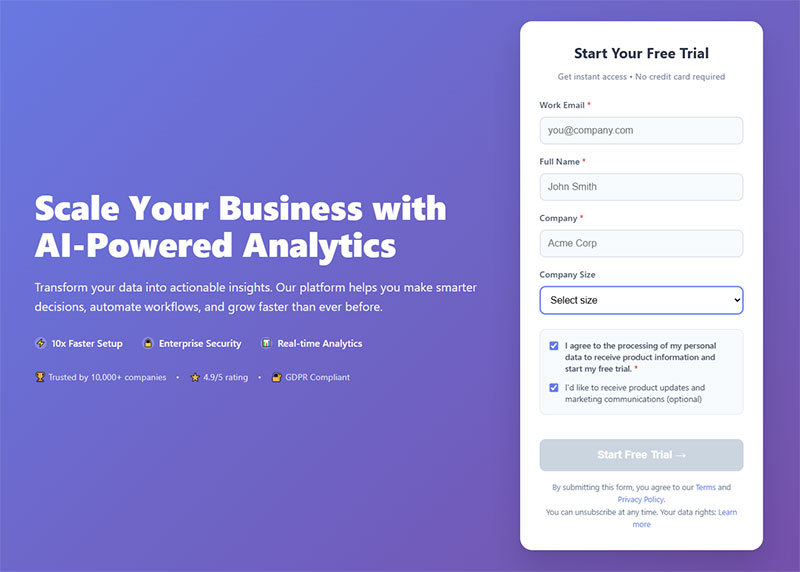
GDPR compliant forms require explicit consent for data collection. Include clear opt-in checkboxes that explain data usage.
Privacy policies must be easily accessible from all forms. Link directly to relevant sections rather than generic policy pages.
Document consent timestamps and IP addresses. Compliance requires proof of explicit permission for data processing.
SSL Certificates and Secure Data Transmission
Secure connections protect form submissions from interception. SSL certificates encrypt data between browsers and servers.
Display security indicators like padlock icons near sensitive information requests. Visual cues build confidence in form security.
Test SSL implementation across all form pages. Mixed content warnings undermine trust and may prevent submissions.
Clear Privacy Policies and Consent Options
Explain data usage in plain language near forms. “We’ll email you weekly tips and never share your information” addresses common privacy concerns.
GDPR consent form examples demonstrate compliant opt-in language. Use specific, actionable consent statements rather than generic permissions.
Provide easy unsubscribe options in all communications. Include links in confirmation emails and follow-up sequences.
Data Retention and Deletion Practices
Document how long you store form data. GDPR requires specific retention periods and deletion procedures.
Implement automated data deletion for inactive leads. Remove outdated contact information to maintain list quality and compliance.
Regular data audits ensure ongoing compliance. Review storage practices quarterly to maintain privacy standards.
Integration with Marketing Tools
CRM System Connections for Lead Management
Connect forms directly to customer relationship management systems. Manual data entry creates delays and increases error rates.
Map form fields to CRM properties accurately. Consistent data structure enables better segmentation and personalization.
Test integration regularly to prevent data loss. Failed connections can lose valuable leads without obvious warning signs.
Email Marketing Platform Integration
Automated email delivery systems handle lead magnet distribution efficiently. Connect forms to email platforms for immediate resource delivery.
Segment new subscribers based on form responses. Different lead magnets indicate varying interest levels and content preferences.
Tag subscribers with form source information. Track which offers generate the most engaged email recipients.
Analytics Tracking and Goal Setup
Configure conversion tracking for all forms. Google Analytics goals measure form submission rates and traffic source performance.
Track form abandonment rates by analyzing where users exit the completion process. This data reveals problematic fields or confusing sections.
Set up event tracking for form interactions. Monitor field focus, validation errors, and completion times for optimization insights.
Marketing Automation Triggers
Connect form submissions to automated nurture sequences. Different forms should trigger relevant follow-up campaigns.
Score leads based on form responses and behavior. Higher scores indicate sales-ready prospects who need immediate attention.
Trigger different workflows for different prospect types. Enterprise leads need different nurturing than small business prospects.
Testing and Improving Form Performance
Key Metrics to Track and Analyze
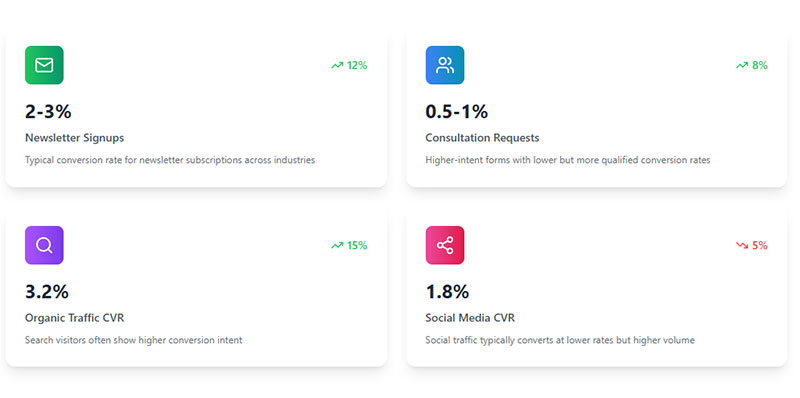
Conversion Rate Measurement and Benchmarks
Conversion rates vary significantly by industry and form type. Newsletter signups typically convert at 2-3% while consultation requests might achieve 0.5-1% rates.
Track conversion rates by traffic source. Organic search visitors often convert differently than social media traffic or paid advertising.
Benchmark against industry standards but focus on improving your own baseline performance. A 0.1% increase can generate significant additional leads.
Form Abandonment Rates and Drop-Off Points

Improving form abandonment rate requires identifying exactly where users exit the process. Analytics tools reveal field-by-field abandonment patterns.
Long forms naturally have higher abandonment rates. Monitor each field to identify problematic questions or confusing instructions.
Mobile abandonment rates typically exceed desktop rates. Optimize mobile experiences separately from desktop versions.
Lead Quality Scoring and Sales Conversion

Measure lead-to-customer conversion rates by form type. High-converting forms generate better prospects even with lower submission volumes.
Track sales cycle length for different lead sources. Some forms attract prospects closer to purchase decisions.
Calculate customer lifetime value by acquisition source. This data justifies higher acquisition costs for premium lead sources.
Traffic Source Performance Comparison
Compare form conversion rates across different traffic channels. Email subscribers often convert better than cold traffic from advertising.
Analyze visitor behavior before form submissions. Users who view multiple pages typically provide higher-quality information.
Paid traffic requires higher conversion rates to maintain positive ROI. Optimize forms specifically for expensive traffic sources.
A/B Testing Strategies for Forms
Testing Headlines and Copy Variations
Test benefit-focused headlines against feature-focused alternatives. “Get our guide” performs differently than “Download 47 proven strategies.”
Single-element tests provide clearest insights. Change only headlines while keeping all other elements constant.
Test emotional triggers in copy. Fear-based messaging (“Don’t miss out”) versus opportunity-based messaging (“Discover how”) appeal to different personalities.
Field Quantity and Type Experiments
Test forms with different field counts. Sometimes adding qualifying questions improves lead quality despite reducing submission rates.
Experiment with field types. Dropdown menus versus text inputs affect completion rates and data quality.
Required versus optional field testing reveals user preferences. Some audiences prefer minimal requirements while others accept detailed forms for valuable offers.
Design and Color Scheme Testing
Button colors significantly impact conversion rates. Test high-contrast options against brand-consistent alternatives.
Form backgrounds and borders affect visual hierarchy. Clean, minimal designs often outperform elaborate styling.
Test form design elements like spacing, fonts, and field sizes. Small visual changes can improve usability significantly.
Button Placement and Text Optimization
Test button positions relative to form fields. Centered buttons perform differently than left-aligned alternatives.
Experiment with action-oriented button text. “Start my free trial” converts differently than “Submit application.”
Button size affects mobile conversions especially. Ensure touch targets meet accessibility guidelines for all devices.
Continuous Improvement Methods
Regular Performance Reviews and Updates
Schedule monthly form performance reviews. Track conversion trends and identify declining offers that need refreshment.
Monitor competitor form strategies for inspiration. Industry changes often reveal new optimization opportunities.
Document testing results for future reference. Build institutional knowledge about what works for your specific audience.
User Feedback Collection and Implementation
Survey form users about their experience. Ask about confusing elements, missing information, or technical problems.
Use session recording tools to watch actual form interactions. Real user behavior reveals issues that analytics might miss.
Implement feedback forms for visitors who abandon the process. Exit surveys explain why prospects didn’t complete submissions.
Competitor Analysis and Inspiration
Research industry leaders’ form strategies. Analyze their lead magnets, field requirements, and design approaches.
Test competitor-inspired variations adapted to your brand. Don’t copy directly but learn from successful patterns.
Monitor competitor changes over time. Successful companies iterate constantly, providing ongoing optimization ideas.
Seasonal Adjustments and Campaign Alignment
Adjust form offers based on seasonal trends. Tax software companies need different lead magnets in December versus March.
Align forms with marketing campaigns and product launches. Coordinated messaging across channels improves conversion rates.
Track performance seasonality to predict optimization timing. Some audiences convert better during specific months or quarters.
Following Up with Generated Leads
Immediate Response Systems
Automated Thank You Emails and Confirmations
Speed matters in lead follow-up. Immediate confirmation emails set expectations and deliver promised resources instantly.
Registration successful message templates should include clear next steps and resource delivery timelines. Generic confirmations miss opportunities to guide prospects forward.
Personalize automated responses with form submission data. Reference specific resources requested or consultation topics mentioned.
Instant Delivery of Promised Resources
Download links should work immediately after form submission. Broken delivery systems lose prospects before nurturing begins.
Host resources on reliable servers with adequate bandwidth. Traffic spikes from successful campaigns can overwhelm slow hosting.
Test resource delivery regularly. Automated systems fail without obvious warning signs.
Next Steps Communication and Expectations
Explain what happens after form submission. Prospects need clear timelines for follow-up calls or additional communications.
Include calendar links for consultation bookings. Self-scheduling reduces friction and accelerates the sales process.
Set realistic expectations for response times. Promising 24-hour callbacks when your team needs 48 hours damages credibility.
Contact Information and Support Options
Provide multiple contact methods in confirmation emails. Phone numbers, support addresses, and chat options give prospects alternatives if primary systems fail.
Include unsubscribe links in all automated communications. Easy opt-out options build trust and ensure compliance.
Make support easily accessible. Confused prospects should find help quickly rather than abandoning the process.
Lead Nurturing Email Sequences
Welcome Series for New Subscribers
Multi-part welcome sequences introduce your company and establish ongoing value. Single confirmation emails miss relationship-building opportunities.
Space welcome emails 2-3 days apart. Daily messages overwhelm while weekly gaps lose momentum.
Focus on education over sales in welcome sequences. Build trust before requesting sales conversations.
Educational Content Delivery Schedules
Match content delivery to subscriber preferences indicated in forms. Weekly tips work for some audiences while monthly reports suit others.
Segment email sequences by lead magnet source. Different resources indicate varying interest levels and content needs.
Track engagement metrics across sequence emails. Open rates and click patterns reveal optimal sending frequency.
Personalized Follow-up Based on Form Responses
Use form data to customize nurture campaigns. Company size, industry, and stated challenges inform relevant content selection.
Tag prospects based on interest areas indicated in forms. Marketing automation platforms enable dynamic content based on these tags.
Score engagement levels throughout nurture sequences. Highly engaged prospects need sales team attention sooner.
Re-engagement Campaigns for Inactive Leads
Identify inactive subscribers based on email engagement patterns. Zero opens over 60-90 days indicate disengagement.
Create win-back campaigns with fresh value propositions. Different lead magnets might re-activate dormant prospects.
Sunset inactive contacts to maintain list health. Poor engagement rates affect overall email deliverability.
Sales Team Handoff Processes
Lead Scoring and Qualification Criteria
Develop point systems based on form responses and behavior. Company size, budget ranges, and timeline indicators create qualification scores.
Set minimum score thresholds for sales handoff. Marketing qualified leads need additional nurturing while sales qualified leads require immediate attention.
Track score accuracy by measuring lead-to-customer conversion rates. Adjust criteria based on actual sales outcomes.
Timely Notification Systems for Hot Leads
Configure instant alerts for high-value form submissions. Consultation requests and enterprise inquiries need immediate sales attention.
Use multiple notification channels for critical leads. Email, SMS, and Slack alerts ensure sales teams see urgent prospects.
Response speed impacts conversion rates significantly. Leads contacted within one hour convert 7x better than those reached after an hour.
CRM Integration for Seamless Transitions
Sync form data directly into CRM systems. Manual data entry creates delays and transcription errors.
Include form source information in CRM records. Sales teams need context about how prospects discovered your company.
Map form fields to appropriate CRM properties. Consistent data structure enables better segmentation and reporting.
Feedback Loops Between Marketing and Sales
Regular sales and marketing meetings improve lead quality over time. Sales teams provide insights about which forms generate better prospects.
Track lead progression through sales stages by form source. This data reveals which lead magnets attract buyers versus browsers.
Closed-loop reporting measures true form ROI. Connect form submissions to actual revenue for accurate performance measurement.
Common Mistakes to Avoid
Form Design and User Experience Errors
Making Forms Too Long or Complex
Every additional field reduces conversion rates. Request only information you’ll actually use for follow-up or qualification.
Break long forms into multiple steps when necessary. Multi-step forms with progress indicators feel less overwhelming than single long pages.
Consider progressive profiling over comprehensive initial forms. Collect additional data through subsequent interactions rather than upfront.
Poor Mobile Optimization
Mobile traffic dominates most websites, yet many forms function poorly on small screens. Touch targets must be large enough for accurate finger taps.
Test forms on actual mobile devices, not just desktop browser simulations. Real-world testing reveals usability issues that simulators miss.
Single-column layouts work better on mobile. Horizontal scrolling and cramped multi-column designs frustrate mobile users.
Confusing or Unclear Instructions
Placeholder text should provide examples rather than field labels. “Enter your email address” works better than “Email” as placeholder text.
Label required fields clearly with consistent indicators. Asterisks, colored text, or “Required” notation should appear uniformly across all forms.
Explain purpose for sensitive information requests. “Phone number for appointment scheduling only” reduces resistance to providing contact details.
Slow Loading or Broken Functionality
Form speed affects conversion rates more than most design elements. Slow-loading forms lose prospects before they see your offer.
Test forms regularly across different browsers and devices. JavaScript errors and compatibility issues cause silent failures.
Monitor form submission success rates. Technical problems often go unnoticed without active monitoring systems.
Strategy and Implementation Mistakes
Not Matching Forms to Page Content
Generic contact forms on specific content pages miss conversion opportunities. Blog posts about email marketing should offer email-related lead magnets.
Align form offers with visitor intent. Product page visitors need different incentives than blog readers or pricing page browsers.
Context determines conversion rates. Relevant offers perform significantly better than generic alternatives.
Weak or Missing Value Propositions
“Join our newsletter” underperforms specific benefit statements. “Get weekly tips that increase website conversions” explains exactly what subscribers receive.
Quantify value when possible. “Save 5 hours per week” feels more compelling than “save time” in form copy.
Address common objections in form descriptions. “No spam, unsubscribe anytime” reduces email capture resistance.
Ignoring Privacy and Compliance Requirements
Form security extends beyond technical protection to legal compliance. GDPR, CCPA, and other privacy laws require specific consent mechanisms.
Link to privacy policies from all forms. Prospects need easy access to understand how their information will be used.
Document consent properly for compliance audits. Store timestamps, IP addresses, and exact consent language for each submission.
Failing to Test and Improve Regularly
Form performance degrades over time without active optimization. Audience preferences change and competitors introduce better offers.
A/B testing should be continuous rather than one-time activities. Small improvements compound over months to create significant gains.
Monitor industry benchmarks to identify optimization opportunities. Conversion rates significantly below industry averages indicate improvement potential.
Follow-up and Lead Management Issues
Slow Response Times to New Leads
Lead response speed dramatically impacts conversion rates. Studies show 50x higher conversion rates for companies responding within 5 minutes versus 30 minutes.
Automated acknowledgment emails buy time for personal follow-up. Set expectations about response timelines while providing immediate value.
Configure multiple notification channels for urgent leads. Email alerts might be missed while SMS or Slack notifications get immediate attention.
Generic, Impersonal Follow-up Messages
Use form submission data to personalize communications. Reference specific resources downloaded or consultation topics mentioned.
Segment follow-up sequences by lead source and qualification level. Enterprise prospects need different messaging than small business leads.
Personalization increases engagement rates significantly. Custom messages outperform generic templates across all industries.
Poor Lead Qualification and Scoring
Develop scoring criteria based on actual customer characteristics. Analyze existing customers to identify common attributes and behaviors.
Track lead score accuracy by measuring conversion rates. Adjust criteria when high-scoring leads fail to convert or low-scoring leads become customers.
Regular sales and marketing alignment meetings improve qualification criteria over time. Sales feedback reveals which characteristics predict actual buyers.
Lack of Integration Between Marketing and Sales
Disconnected systems create gaps where leads fall through cracks. CRM integration ensures all form submissions reach appropriate team members.
Establish clear handoff criteria and processes. Both teams need to understand when leads transition from marketing to sales ownership.
Measure end-to-end conversion from form submission to customer. This data reveals system gaps and optimization opportunities throughout the entire process.
FAQ on Using Website Forms For Lead Generation
What is the optimal number of form fields for lead capture?
Three to five fields maximize conversion rates while gathering essential contact information. Email address remains mandatory, while name and company details provide personalization data. Additional fields should offer clear value exchanges through progressive profiling techniques.
How do I reduce form abandonment rates effectively?
Streamline form design and eliminate unnecessary fields. Use real-time validation, clear error messaging, and mobile optimization. Multi-step forms with progress indicators feel less overwhelming than single long pages for complex information requests.
What lead magnets generate the highest conversion rates?
Industry-specific guides, templates, and free consultations perform best. Educational content like ebooks and checklists provide immediate value. Service-based incentives such as assessments and demos attract higher-quality prospects for B2B companies.
Where should I place forms on my website for maximum visibility?
Above-the-fold positioning on landing pages captures immediate attention. Sidebar placement maintains ongoing visibility, while in-content forms target engaged readers. Exit intent popup strategies recover abandoning visitors effectively.
How quickly should I follow up with new leads?
Response within five minutes increases conversion rates by 900%. Automated confirmation emails provide immediate value while sales teams prepare personalized outreach. Set clear expectations about follow-up timing in confirmation messaging.
What information should I request in lead generation forms?
Request only data you’ll actively use for segmentation or follow-up. Essential fields include email, name, and company information. Optional qualifying questions about budget, timeline, and specific needs improve lead scoring accuracy.
How do I ensure my forms are mobile-friendly?
Single-column layouts with large touch targets work best on mobile devices. Test forms on actual smartphones, not just browser simulations. Mobile forms need simplified field types and minimal horizontal scrolling.
What privacy compliance requirements affect lead generation forms?
GDPR requires explicit consent for data collection and processing. Include clear opt-in checkboxes, link to privacy policies, and provide easy unsubscribe options. GDPR compliant forms need documented consent with timestamps.
How do I measure form performance and conversion rates?
Track submissions, abandonment rates, and lead quality metrics. Monitor conversion rates by traffic source and form placement. A/B testing reveals optimal headlines, field counts, and design elements for your specific audience.
What CRM integration features improve lead management?
Automated data sync eliminates manual entry and reduces errors. Map form fields to CRM properties accurately for proper segmentation. Real-time notifications ensure sales teams contact hot leads immediately for maximum conversion potential.
Conclusion
Mastering how to use website forms for lead generation requires strategic planning, thoughtful design, and continuous optimization. Successful lead capture systems balance user experience with business objectives through compelling value propositions and streamlined conversion processes.
Key success factors include strategic form placement, mobile optimization, and immediate follow-up systems. Sign up forms that capture qualified prospects generate sustainable sales pipeline growth when integrated with marketing automation and CRM systems.
Testing and iteration drive long-term performance improvements. A/B testing reveals audience preferences while analytics tracking identifies optimization opportunities across different traffic sources and campaigns.
Your customer acquisition strategy depends on converting anonymous visitors into engaged prospects. Implement these proven techniques to transform website traffic into valuable leads that fuel business growth and revenue generation consistently.


